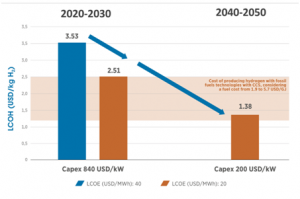by Dolf Gielen and Emanuele Taibi, via Energy Post

Although 100Mt/year of hydrogen is produced globally and at scale, it’s overwhelmingly for the chemical industry. So there’s a long way to go for it to play a role in the energy transition. It’s not even clear whether hydrogen will be best used directly as a power source or through further conversion into other powerfuels. That’s why Dolf Gielen and Emanuele Taibi at IRENA are scoping out the challenges of reducing production costs and finding markets. The cost of the clean electricity used to power hydrogen manufacture (making it emission-free, as producing it from coal plants would be pointless without CCUS) is crucial. The cost and efficiency of the electrolysers used to create it, too. The cost of liquefying this highly volatile gas for transportation and storage adds substantially to the lifecycle efficiency losses. Although costs will come down, the authors predict a high carbon price will still be needed, even in 2050, to make it competitive with gas. Those costs are indeed falling which explains why, along with the urgency of climate change, clean hydrogen is gaining political and business momentum, explain the authors. And with lower costs will come the markets: vehicle fuel cells, conversion to powerfuels, utilising the spare capacity of renewables, and replacing gas.
Hydrogen is high on the agenda of the new European Commission. Frans Timmermans (EC Executive Vice-President for the European Green Deal) spoke at a stakeholder forum of the Fuel Cell and Hydrogen Joint Undertaking on 21st November.
He stated that Europe should extend its lead in clean hydrogen through quick successes. Hydrogen in existing gas infrastructure can go hand-in-hand with increasing the share of electricity in Europe’s energy system, allowing storage of renewable electricity surpluses.